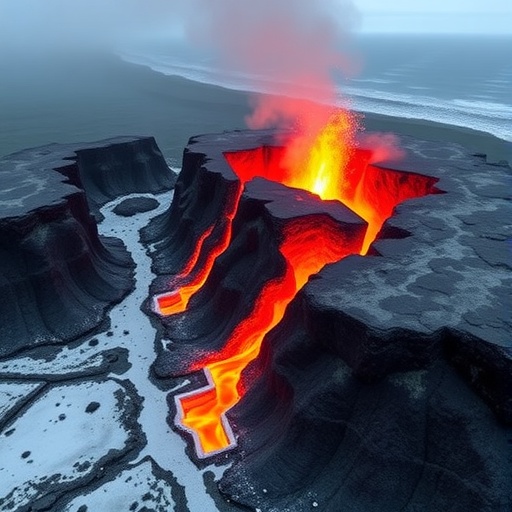Deep beneath the world’s oceans, along the massive submarine mountain ranges known as mid-ocean ridges, a groundbreaking discovery is reshaping our ability to monitor volcanic activity. A recent study unveiled by an international team of researchers offers compelling evidence that temperature fluctuations in hydrothermal vents—natural outlets where superheated seawater escapes from beneath the earth’s crust—serve as real-time indicators of tectonic and magmatic dynamics occurring miles below the seafloor. This breakthrough heralds a new frontier in oceanic geophysics by providing a predictive window into submarine volcanic eruptions.
The study, published in the prestigious Proceedings of the National Academy of Sciences, centers on the East Pacific Rise at latitude 9°50’N, a segment of the mid-ocean ridge system renowned for its frequent volcanic activity. For over three decades, scientists have been recording the temperatures of hydrothermal fluids emitted by vents along this ridge. The data reveals that subtle temperature elevations—ranging from 350°C to nearly 390°C—occurred consistently prior to two major eruption periods in the early 1990s and mid-2000s. This thermal signature reflects underlying magmatic processes, specifically the inflation of magma chambers located approximately one mile beneath the seafloor, which exert rising pressure on the surrounding geological formations.
Hydrothermal vents form when ocean water penetrates the oceanic crust, becoming intensely heated as it interacts with hot basaltic rocks heated by underlying magma. This process not only circulates enormous amounts of thermal energy but also supports complex ecosystems reliant on chemical energy rather than sunlight. The precise temperature readings from these vents provide direct clues about subsurface magmatic activity because any increase in magma volume inflates the chamber, raising pore fluid pressure and causing measurable increases in vent outlet temperatures.
What makes this study particularly transformative is its predictive power. By integrating temperature monitoring with analytical models of crustal deformation and pressure changes, the research team detected signals that anticipated the 2025 volcanic eruption along the East Pacific Rise — a rare and significant success in submarine eruption forecasting. Such predictive capability has long eluded scientists due to the formidable challenges of deep-sea observation and the complex interactions driving seafloor volcanism. Autonomous sensors capable of continuously measuring temperature changes are increasingly enabling these insights, marking the dawn of near-real-time monitoring of oceanic tectonic events.
Leading the charge is Dr. Thibaut Barreyre, who, along with collaborators from the Woods Hole Oceanographic Institution, Lehigh University, and Scripps Institution of Oceanography, assembled one of the most comprehensive long-term datasets of hydrothermal vent temperatures ever created. The painstaking collection and analysis of this 35-year time series have been pivotal in connecting temperature trends to magmatic inflation cycles beneath the seafloor. These findings illuminate how thermal and mechanical processes beneath the ocean floor are intricately linked and can be monitored remotely by interpreting thermal anomalies at vent sites.
Dan Fornari, a veteran WHOI scientist and co-author of the study, emphasizes the crucial nature of this connection. According to Fornari, mid-ocean ridges serve as Earth’s primary conduits for transferring internal thermal energy to the ocean, yet until now, there was no direct observational link between surface measurements at the seafloor and the deep magmatic processes driving volcanic activity. This research bridges that gap by demonstrating that vent fluid temperature directly correlates with magma chamber inflation, providing an unprecedented ability to detect changes in magmatic pressure before eruptions occur.
Hydrothermal vent fluids reaching temperatures exceeding 350°C emerge under extreme pressure, and variations in these temperatures are minute but significant. By tracking these variations meticulously over years, scientists can discern patterns of increasing magmatic inflation—a process where the molten rock body beneath the seafloor expands gradually, compressing surrounding rock and fluids, thus altering vent temperatures. These thermal shifts act as a geophysical alarm, signaling transitions in tectonic and volcanic regimes that were previously invisible to surface instruments.
The implications of this research are profound. Its success in forecasting a mid-ocean ridge eruption months in advance demonstrates the feasibility of establishing global monitoring networks equipped with long-duration, autonomous sensors that can relay continuous data about seafloor conditions. Such networks would revolutionize ocean monitoring, providing early warnings of volcanic hazards, enhancing understanding of ocean-crust interactions, and contributing to global efforts to map the dynamic processes shaping the Earth’s lithosphere.
Furthermore, this study underscores the interdisciplinary nature of submarine geoscience. It combines geophysical measurements, chemical oceanography, and ocean engineering to link magma dynamics to observable surface phenomena. By leveraging robotics—such as the human-occupied vehicle Alvin which participated in verifying the 2025 eruption in situ—the research exemplifies the synergy of human and technological exploration in deep-sea science.
Scientists now envision a future where hydrothermal vent temperature data become integral to seismic and volcanic hazard assessment, especially along mid-ocean ridges that encircle the globe and produce a large portion of the planet’s magma. Continuous observation along these ridges will not only enhance safety and scientific prediction but also broaden knowledge of the fundamental Earth processes driving plate tectonics, ocean chemistry, and marine ecosystems.
In summary, this pioneering work establishes hydrothermal vent temperature measurements as a vital proxy for tectonic and magmatic activity beneath the ocean floor. By decoding these thermal signals, scientists have unlocked a previously inaccessible dimension of geological monitoring. The expanding capability to “listen” to the tectonic rhythms of the seafloor signals a major leap forward in understanding our planet’s inner workings with deep implications for oceanography, geology, and hazard preparedness worldwide.
Subject of Research: Not applicable
Article Title: “Hydrothermal vent temperatures track magmatic inflation and forecast eruptions at the East Pacific Rise, 9°50’N”
News Publication Date: 13-Oct-2025
Web References:
- https://www.pnas.org/cgi/doi/10.1073/pnas.2510245122
- https://www.whoi.edu/ocean-learning-hub/multimedia/east-pacific-rise/
- https://www.whoi.edu/press-room/news-release/scientists-in-alvin-witness-seafloor-eruption-on-the-east-pacific-rise/
References:
Barreyre, T., et al. “Hydrothermal vent temperatures track magmatic inflation and forecast eruptions at the East Pacific Rise, 9°50’N.” Proceedings of the National Academy of Sciences, vol. 122, no. 41, 2025, doi:10.1073/pnas.2510245122.
Image Credits: Photo courtesy of Jill McDermott, Lehigh University; Woods Hole Oceanographic Institution (WHOI), National Deep Submergence Facility Alvin Team; Funded by National Science Foundation. © Woods Hole Oceanographic Institution
Keywords: Earth sciences, Chemistry, Materials science




